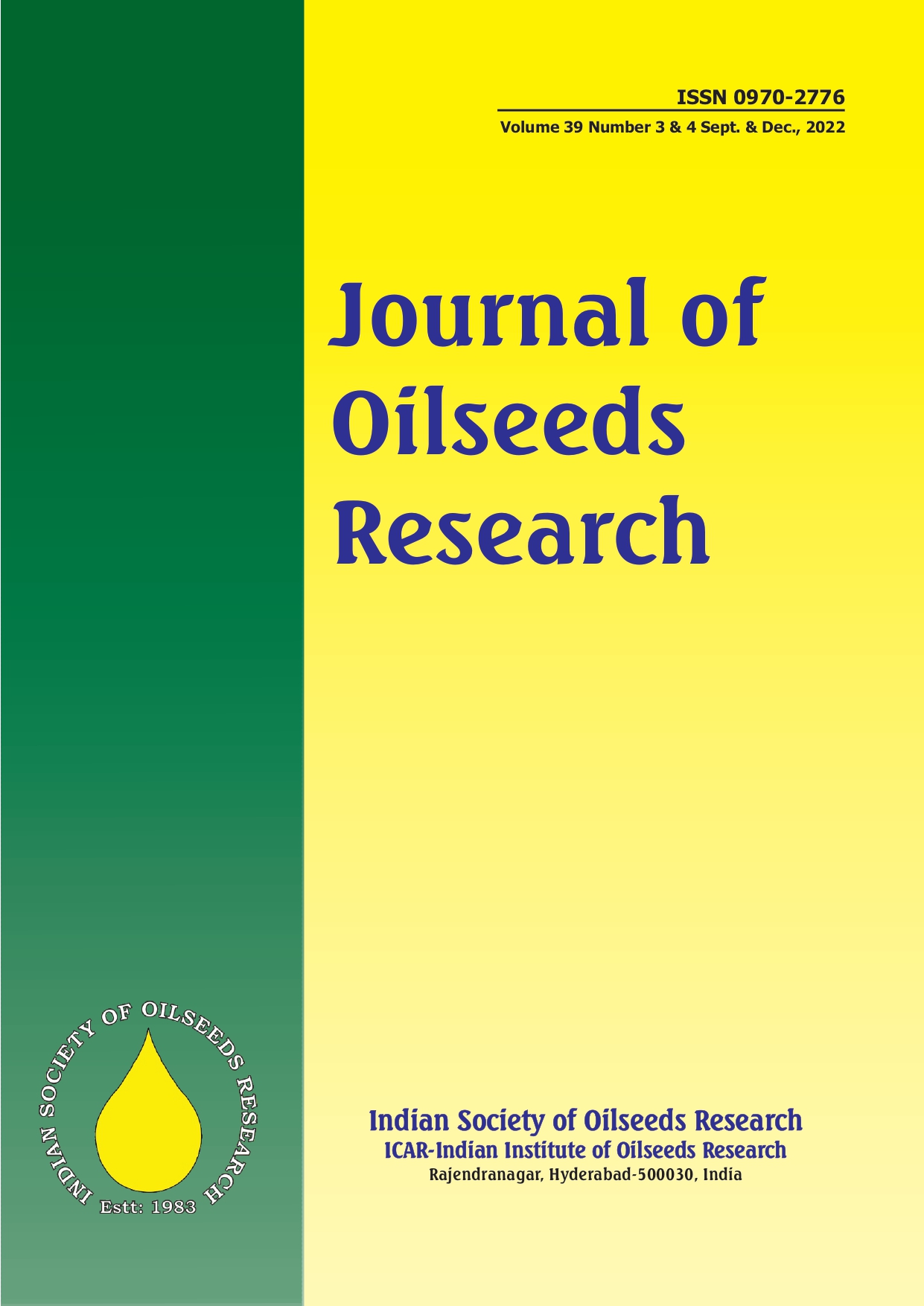Identification of resistant sources for gall fly, Asphondylia sesami Felt (Diptera: Cecidomyiidae) in sesame
IDENTIFICATION OF RESISTANT SOURCES FOR GALL FLY, ASPHONDYLIA SESAMI FELT IN SESAME
195 / 3
Keywords:
Sesame, Gall fly, Population, Incidence, Genotypes, Reaction, SeasonsAbstract
The incidence of the gall fly, Asphondylia sesami Felt (Diptera: Cecidomyiidae) is common during flowering period ofsesame during two seasons. The sesame genotypes (n=60) were screened for A. sesami during two season1 and 2. In season 1, two genotypes, ISWG-20-05 and IIOS-1103 were found free from A. sesami incidence. The sesame genotypes (n=60) graded for A. sesami as resistant (59 genotypes), moderately resistant (1 genotype) based on incidence. In season 2, two genotypes, SES-K-20-2015 and IC-16239 were found free from A. sesami incidence. The sesame genotypes (n=60) graded for A. sesami as resistant (29 genotypes), moderately resistant (22 genotypes), moderately susceptible (8 genotypes) and susceptible (1 genotype) based on incidence. To summarize, 28 genotypes were resistant to A. sesami in both season 1 (2021) and 2 (2022) and the resistant genotypes can be used as donor in future breeding programmes.
Downloads
References
Ahuja D B and Kalian R K 2001. Seasonal incidence of gall fly, Asphondylia sesami and efficacy of various nee, based formulation, against it on sesame. Indian Journal of Entomology, 63(4): 409-412.
Baskaran R K, Mahadevan N R, Sathiyanadam V K and Thangavelu S 1997. Approaches prevention and control of sesame pests. Recent Advances in Entomological Research. Regional Research Station. Tamil Nadu Agricultural University, pp. 133-136.
Biswas G C, Kabir S M H and Das G P 2001. Insect pest of sesamum (Sesamum indicum Linn.) in Bangladesh, their succession and natural enemies. Indian Journal of Entomology, 63: 117-124.
Boopathi T and Sujatha M 2022. Emerging insect pests of sesame under changing climate scenario. Vikaspedia, India Development Gateway, Ministry of Electronics and Information Technology, Government of India, India. doi: https://vikaspedia.in/agriculture/crop-production/integrated-p est-managment/ipm-for-oilseeds/ipm-strategies-for-sesame/e merging-insect-pests-of-sesame-under-changing-climate-scenario.
Kumhar S R and Rajani Bisen 2021. Genetic analysis and diversity studies in sesame (Sesamum indicum L.). Journal of Oilseeds Research, 38(4): 329-336.
Muzaffar A T, Rab D K, Maqsood A R and Imtiaz A N 2002. Insect pests associated with sesame at Tando Jam. Pakistan Journal of Applied Science, 2(7): 723-726.
Ogwal S, Anyanga W, Odul C and Oumo J 2003. Screening of sesame breeder's lines for resistance/ tolerance to gall midge and sesame webworb insect pests of sesame. NAROARTP2 Annual Report 2002-2003. National Agricultural Research Organisation, Ministry of Agriculture Animal Industry and Fisheries, Kampala, Uganda.
Ranganatha A R G, Jyotishi A, Deshmukh M R, Bisen R, Panday A K, Gupta K N, Jain S and Paroha S 2013. Improved Technology for Maximizing Production of Sesame. All India Coordinated Research Project on Sesame and Niger, Indian Council of Agricultural Research, JNKVV Campus, Jabalpur, Madhya Pradesh, India. 28p.
Solanki Z S, Singh I, Rajpurohit T S and Ahuja D B 2006. Combining ability and heterosis for stem and root rot and leaf webber/capsule borer in sesame. Indian Journal of Crop Science, 1(1-2): 171-174.
Vamshi P, Ramya K T, Santhalakshmi M P, Ramana J V and Kumhar S R 2021. Genetic variability studies for yield and yield attributes in breeding lines of sesame (Sesamum indicum L.). Journal of Oilseeds Research, 38(3): 240-243.
Weiss E A 2000. Oil Seed Crop, 2nd Edition, Blackwell ScienceInc.
